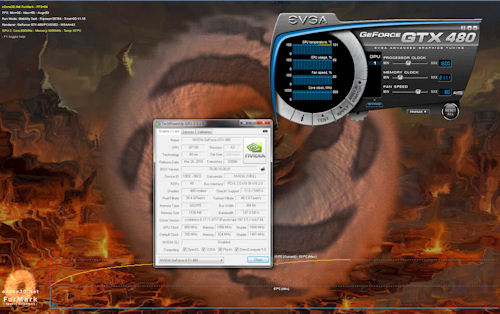HEXUS.bang4buck at 1,920x1,200 and 2,560x1,600, plus overclocking
In a rough-and-ready assessment of the cards' bang for buck, we've aggregated the 1,920x1,200 and 2,560x1,600 frame-rates for five games, normalised them* and taken account of the cards' prices.
But there are more provisos than we'd care to shake a stick at. We could have chosen five different games, the cards' prices could have been derived from other sources and pricing tends to fluctuate daily.
Consequently, the tables below highlight a metric that should only be used as a yardstick for evaluating comparative performance with price factored in. Other architectural benefits are not covered, obviously.| Graphics cards | HIS Radeon HD 5970 2,048MB | Sapphire Radeon HD 5870 1,024MB | Sapphire Radeon HD 5850 1,024MB | NVIDIA GeForce GTX 480 1,536MB | BFG GeForce GTX 295 1,792MB | BFG GeForce GTX 285 1,024MB | EVGA GeForce GTX 275 896MB |
|---|---|---|---|---|---|---|---|
| Actual aggregate marks at 1,920x1,200 | 479.12 | 342.43 | 295.68 | 432.89 | 363.16 |
259.49 |
234.23 |
| Aggregate marks, normalised*, at 1,920x1,200 | 364.02 |
289.59 |
254.29 |
334.22 | 295.16 |
224.23 |
202.39 |
| Current pricing, including VAT | £550 | £310 | £225 | £440 (estimated) | £350 | £275 | £199 |
| HEXUS.bang4buck score at 1,920x1,200 | 0.662 | 0.934 | 1.13 | 0.759 |
0.843 |
0.815 | 1.017 |
| HEXUS.bang4watt score at 1,920x1,200** | 0.793 | 0.905 | 0.892 |
0.704 |
0.584 |
0.598 |
0.552 |
2,560x1,600
| Graphics cards | HIS Radeon HD 5970 2,048MB | Sapphire Radeon HD 5870 1,024MB | Sapphire Radeon HD 5850 1,024MB | NVIDIA GeForce GTX 480 1,536MB | BFG GeForce GTX 295 1,792MB | BFG GeForce GTX 285 1,024MB | EVGA GeForce GTX 275 896MB |
|---|---|---|---|---|---|---|---|
| Actual aggregate marks at 2,560x1,600 | 346.21 |
244.84 | 209.28 | 290.29 | 264.78 |
NA |
NA |
| Aggregate marks, normalised*, at 2,560x1,600 | 284.53 |
216.92 |
175.2 |
240.53 | 233.2 |
NA |
NA |
| Current pricing, including VAT | £550 | £310 | £225 | £440 (estimated) | £350 | £275 | £199 |
| HEXUS.bang4buck score at 2,560x1,600 | 0.517 | 0.7 | 0.779 | 0.547 | 0.666 | NA | NA |
* the normalisation refers to taking playable frame rate into account. Should a card benchmark at over 60 frames per second in any one game, the extra fps count as half. Similarly, should a card benchmark lower, say at 40fps, we deduct half the difference from its average frame rate and the desired 60fps, giving it a HEXUS.bang4buck score of 30 marks. The minimum allowable frame rate is 20fps but that scores zero.
** the HEXUS.bang4watt score is a crude measurement of how much normalised performance the GPU provides when evaluated against peak system-wide power-draw that's shown on the previous page: the former is divided by the latter. Bear in mind that FurMark, the application used, tends to load up NVIDIA cards a touch more than AMD's.
The HEXUS.bang4buck score only takes the performance and price into account, of course.
Evaluation
AMD's Radeon HD 5870 isn't as fast as the GeForce GTX 480, clearly, but its significantly lower street price means that it offers more HEXUS.bang4buck at both resolutions. However, NVIDIA's better-than-expected pricing means that neither GeForce 400-series card is a stinker in the value department.
Overclocking
We increased the fan-speed to 80 per cent (<4,000rpm) and then used EVGA's Precision tool to force up the clocks. From the default 700MHz/1,400MHz/3,698MHz clockings for core, shader and memory, respectively, we hit 800MHz/1,600MHz/ 4,224MHz, representing a 14 per cent increase over stock. System-wide power-draw increases from a peak 475W to 525W.
Looking a the 2,560x1,600 results, Far Cry 2 (8x AA) performance rose from 54.91fps to 61.3fps and DiRT 2 DX11 from 50.69fps to 56.78fps.










